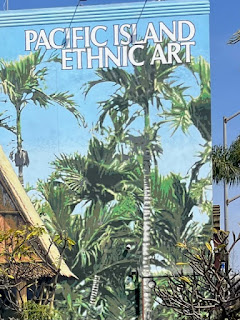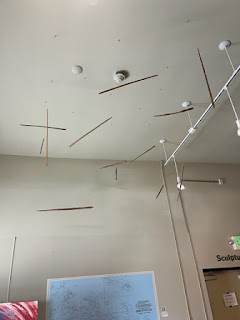Visiting Pacific Island Ethnic Art Museum
- Hispano Americano Heroes

- Aug 28, 2024
- 3 min read
Excerpt from The World Through Rosie Colored Glasses:
Mimi has a friend, Dr. Victor Thompson. He is a gentle, extremely accomplished man of Samoan descent. He was instrumental in the development of the Pacific Island Ethnic Art Musuem - PIEAM for short. The museum is located in Long Beach, California. We got a private tour on March 22nd.
Straight from the website - "Throughout all the Pacific Islands of Oceania, there has always been a central meeting place, a community house." Thanks to the Tongva people, this small museum is a wonderful example of the welcoming reception and feeling of "ohana" that the island people have as part of their culture.
This museum was created as a project of the Robert Gumbiner Foundation. Dr. Gumbiner was a practicing physician who founded FHP, a large HMO in Southern California. It opened in 2010.
As you enter PIEAM, there are examples of hand-woven clothing that is typical of the Oceanic peoples.
Our lovely guide explained the meaning of the textiles and introduced us to the meeting house.
Above our heads hung several items that looked like arrows or spears. They are actually love sticks. When a man wants to be with a woman, he pushes the love stick halfway through the wall of her house. If she pulls it in, she has accepted him. If she pushes it out, sorry Charlie.
Here is another view of the meeting house.
Inside is a sand art piece that was done when the meeting house was built at PIEAM.
There were examples of the different types of basketry that is done in the islands.
The artist River Garza painted two coyote pictures and donated them to PIEAM. They were hung amongst some Oceanic masks and weavings. On the floor were a few family altars. They had family artifacts such as medicine bowls and hand-crafted necklaces.
Two large red crow paintings were done by the Native American artist Weshoyot Alvitre and are displayed on either side of a cluster of intricate native carvings, mostly from Tonga.
This family altar was from the Hawaiian Islands and celebrated Mauna Kea.
Dr Thompson treated us to several beautiful songs that he skillfully played on his ukelele.
Then we had a picnic lunch, also provided by Dr. Thompson, in the sculpture garden behind the building.
As you exit, there is a charming koi pond filled with fat, happy fish.
Tapestries and canvases provide shade and a place to rest.
There are a variety of native sculptures that surround you, including these Tapwanu idols.
These stones are money - they are carried and not rolled from place to place. These Rai are indigenous currency from the Yap islands. The stones are quarried in Palau and brought over to whomever they are owed to by outrigger canoe.
Our private tour also included a pass to MOLAA - the Museum of Lattin American Art, which is directly across the street from PIEAM.
This large piece by Betsabee Romero sits out in front of MOLAA. It is called "Asphalt Spindle" and illustrates the frustration of Mexican warriors held in captivity by the Spanish invaders.
There were five large galleries. This one focused on a large glass sculpture and other examples of urban themed art. These large-scale pieces were mostly done by a Cuban artist named Alexandre Arrechea. He is multidisciplinary, making paintings, large installations, sculptures, photos and video art.
Another striking piece of his was glass punching bags, reminding us of the importance of the sport of boxing to the Cuban people. All of Arrechea's pieces are linked to historical references and traditions from Cuba.
Another gallery was devoted to the Brazilian artist Andrey Guiana Zignatto. His use of masonry bags and implements was derived from his work as a mason's assistant when he was 10-14 years old. His works combine the urban influence of Sao Paolo with his indigenous Inhampuambacu roots.
This piece, called Bird Women, was done by Alejandra Phelts, and was part of an exhibit called Cross Border Women. The works were intended to record the desires for family and the factory work experiences of women from Tijuana. They are not victimizing, rather they portray the links between intimacy and familial relationships and paint a happy picture of life.
Here are Dr Thompson, Mimi and I in the gift shop at MOLAA.




























Comments